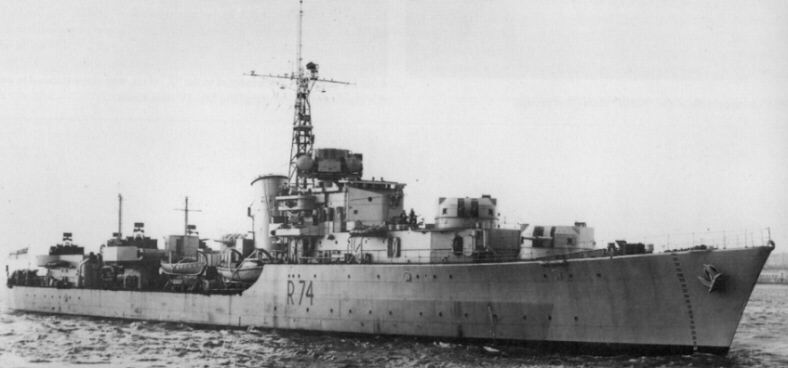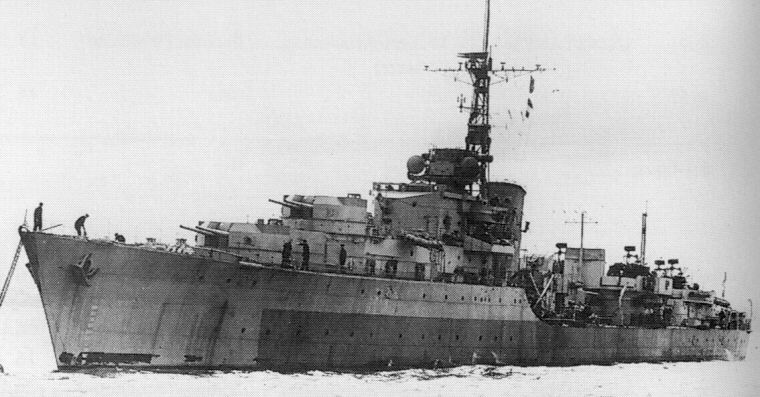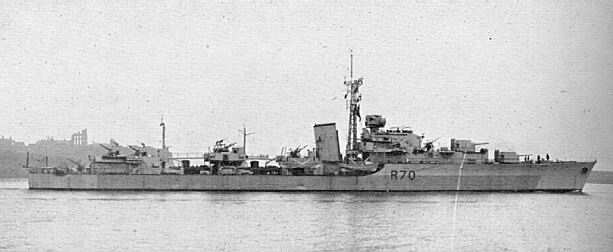| Battle class AA
Destroyers |
| |
| Name |
Pennant |
Builder |
Completed |
Fate |
| Group
I |
| Armada |
R14 |
Hawthorn Leslie |
2/7/45 |
Scrapped 1965 |
| Barfleur |
R80 |
Swan Hunter |
14/9/44 |
Scrapped 1966 |
| Cadiz |
R09 |
Fairfield |
12/4/46 |
To Pakistan 1956, as Khaibir, sold
later |
| Camperdown |
R32 |
Fairfield |
18/6/45 |
Scrapped 1970 |
| Finisterre |
R55 |
Fairfield |
11/9/45 |
Scrapped 1967 |
| Gabbard |
R47 |
Swan Hunter |
10/12/46 |
To Pakistan 1956, as Badr, sold later |
| Gravelines |
R24 |
Cammel Laird |
14/6/46 |
Scrapped 1961 |
| Hogue |
R74 |
Cammel Laird |
24/7/45 |
Scrapped 1962 |
| Lagos |
R44 |
Cammel Laird |
2/11/45 |
Scrapped 1967 |
| St.
James |
R65 |
Fairfield |
12/7/46 |
Scrapped 1961 |
| St.
Kitts |
R18 |
Swan Hunter |
21/4/46 |
Scrapped 1962 |
| Saintes |
R84 |
Hawthorn Leslie |
27/9/46 |
Scrapped 1972 |
| Sluys |
R60 |
Cammel Laird |
30/9/46 |
To IIN 1967, as Artemis, sold later |
| Solebay |
R70 |
Hawthorn Leslie |
11/10/45 |
Scrapped 1967 |
| Trafalgar |
R77 |
Swan Hunter |
23/7/45 |
Scrapped 1970 |
| Vigo |
R37 |
Fairfield |
9/12/46 |
Scrapped 1964 |
| Group
II |
| Agincourt |
I06 |
Hawthorn Leslie |
25/6/47 |
Scrapped 1974 |
| Aisne |
I22 |
Vickers-Armstrongs |
20/3/47 |
Scrapped 1970 |
| Alamein |
I17 |
Hawthorn Leslie |
21/5/48 |
Scrapped 1964 |
| Barrosa |
I68 |
John Brown |
14/2/47 |
Scrapped 1978 |
| Matapan |
I43 |
John Brown |
5/9/47 |
Scrapped 1979 |
| Corruna |
I97 |
Swan Hunter |
6/6/47 |
Scrapped 1974 |
| Dunkirk |
I09 |
Stephens |
27/11/46 |
Scrapped 1965 |
| Jutland
ex- Malplaquet |
I62 |
Stephens |
30/4/47 |
Scrapped 1965 |
| |
 |
| 1:600 Group 1 Battle, as Armada,
Barfleur, Camperdown and Hogue
were completed, with "Hazemeyer" mountings
for their twin 40mm AA ( AR type 282 RDF ) and a 4"
starshell gun abaft the funnel. Note the single 40mm AA
aroung the bridge, were it had originally been intended
to fit 20mm AA. The other vessels had the 4"
replaced by two single 40mm's, and the twins were on
"STAAG" mounts. © Andrew Arthur |
This design was drawn up in 1941, ahead of the 1942 destroyer
programme, and was designed primarilly with AA defence in mind, (
it was at last recognised that this form of attack needed a lot
of defence against ) and as such they had unrivalled AA power in
the RN's destroyer fleet. Until then, not only had the lack of a
suitably stable destroyer hull, high and low elevation gun and
fire control system prevented a class like this; so had the need
for "utility" destroyers to fill up the holes in the
fleet as fast, cheaply and economically as possible.
Originally, a 4.7" gun of 85 degrees elevation, fully
automatic training / elevation and a fully stabilised hull was
considered, along with a heavy and uniform secondary battery of
twin, stabilised and RDF controlled Bofors 40mm AA ( the 2pdr.
pom-pom was at last recognised as a wholly inadequate medium
range weapon, being little more than a grossly oversized Maxim
machine-gun. ) However, the decision to adopt a 4.5" gun as
standard througout the destroyer fleet, to replace both the
4" and 4.7" calibres led to the adoption of Mk.IV twin
turrets for the 4.5" gun being adopted.
The Mk.IV turrets were mounted well forward, with clear arcs of
fire on the broadsides and ahead, controlled by a Mk.VI HA/LA DCT
on the bridge, with AR type 275 radar. A single 4" AA gun
was placed in between the funnel and forward tubes, for the
purpose of firing starshell, and two twin 20mm AA were mounted
forward of the bridge,, on the quarterdeck, and singles in the
bridge wings. The AA armament was completed with two sided twin
40mm AA between the torpedoes, and two of the same en-echelon
between the aft tubes and quarterdeck,
RDF comprised of AR types 275 and 282 for fire control, SW type
272 on the lattice foremast, and AW type 291 on the mainmast
aft.
With the larger hull more akin to the Tribal than the
"utility" types, but 3.25' more beam, and little
more displacement, than the previous, they were very stable, and
due to this and their unpopularity, only Camperdown and Finisterre
had fin stabilisers.
Completion was delayed by the lack of Mk.VI DCT, and so
modifications to the design were added; with all the forward 20mm
guns being replaced by single 40mm Bofors, and in all but Armada,
Barfluer, Camperdown and Hogue, the
4" gun was replaced by sded single Bofors, and the
"Hazemeyer" ( RDF type 282 ) twin Bofors were replaced
by "STAAG" ( RDF type 262 ) twin Bofors. Saintes,
for a short while, carried the prototype Mk.VI turret of the
"D" and later destroyer classes in "B"
position.
They were undoubtedly THE best destroyers produced wartime, and
probably THE best traditional 'gun and torpedo' destroyer ever
built by the RN; their large, spacious hulls seeming a luxury
compared to the "S" class hulls that were pushed to the
limits of stress in the "Z" and "Ca-"
classes. They were also one of the most beautiful classes, even
if their armament seemed to be a bit lop-sided in arrangement.
| |
 |
| 1:600 Group 2 Battle. the only real
external differences were the USN Mk.37 DCT ( GR type 275
RDF ), the single 4.5" gun amidships ( same type as
"Z" class ) to simplify battery control and
supply arrangments and the modified light AA armament. (
two less single 40mm AA and a single twin with a director
replacong the two twins of the group I's ) © Andrew
Arthur |
Externally, the Battle group II's differed in that
they had USN Mk.37 DCT, with the excellent GR type 275 RDF, a
single 4.5" gun replaced the 4" amidships, for a
homogenous battery, and simplifying control and supply
arrangements, and a modified light AA armament.
However, a lot of planning went into the design, although most of
it never came around, mainly due to how to fit the huge,
automatic, Mk.VI turret into the Battle's hull.
However, due to the end of the war, the vessels that had been
planned to carry the Mk.VI turret ( with an enlarged beam ) were
not completed, and the class retained it's similarity to the
predecessors. A squid mortar was also worked in aft, the Group
1's single DC rack being rather pitiful in capacity. Also, the
forward twin 20mm AA, to be replaced by single 40mm's were not
fitted, and the vessels shipped only the wing Bofors instead.
The two STAAG mountings amidships were removed, and a single twin
with am RDF type 282 fitted director tower was fitted, on the
centreline. The inly other RDF changes was the different set on
the DCT.
| Pictures of Battle class AA Destroyers |
 |
| Agincourt in Malta, 1957. Note single
4.5" DP, high Mk.37 DCT and the single midships
Bofors |
 |
| HMS Camperdown, with the
"Hazemeyer" Bofors visible aft, and the low
Mk.VI DCT crowning the bridge. |
 |
| Hogue at anchor. This shows the Mk.IV
4.5" guns well, and the RDF aerials on the
"Hazemeyer" Bofors aft. |
 |
| Saintes running trials; she has the single
but not the twin 40mm's added, and does not carry a
4" AA gun aft of the funnel. |
 |
| HMS Solebay, 40mm Barrels elevated. Note
high freeboard of this hull forward - lovely dry ships
compared to a "Z" class. |
| |
| Dimensions |
| |
Group I |
Group II |
|
Group I |
Group II |
| Full
Displacement |
3290
tons |
3400 tons |
Length |
379' |
379' |
| Empty
Displacement |
2315
tons |
2380 tons |
Beam |
40.25' |
40.5' |
| Load |
975
tons |
1020 tons |
Draft |
15.25' |
15.25' |
| Performance
& Propulsion |
| Machinery |
2 x Admirality 3 drum boilers, 2 x Parsons
geared steam turbines @ 50000 hp |
| Speed |
35.75
kts, 31.25 kts full |
Range |
4400 nm @ 20 kts. |
| Armament &
Complement |
| |
Group I |
Group II |
| Complement |
247
or 308 Officers & Ratings |
232 or 268 Officers
& Ratings |
| Armament |
Group I,
First 4 vessels |
- Gun
- 2 x 2 x 4.5" Mk. IV
DP
- 1 x 1 x 4" AA
- 4 x 2 x 40mm
"Hazemeyer" Bofors AA
- 4 x 1 x 40mm Bofors AA
- Torpedoes
- ASW
|
Group I
Other vessels |
- Gun
- 2 x 2 x 4.5" Mk. IV
DP
- 4 x 2 x 40mm
"STAAG" Bofors AA
- 6 x 1 x 40mm Bofors AA
- Torpedoes
- ASW
|
| Group II |
- Gun
- 2 x 2 x 4.5" Mk. IV
DP
- 1 x 1 x 4.5" DP
- 2 x 2 x 40mm
"STAAG" Bofors AA
- 1 x 2 x 40mm
"STD" Bofors AA
- 2 x 1 x 40mm Bofors AA
- Torpedoes
- ASW
- 1 x
12" triple barrel Squid mortar
- Depth
Charges
|






